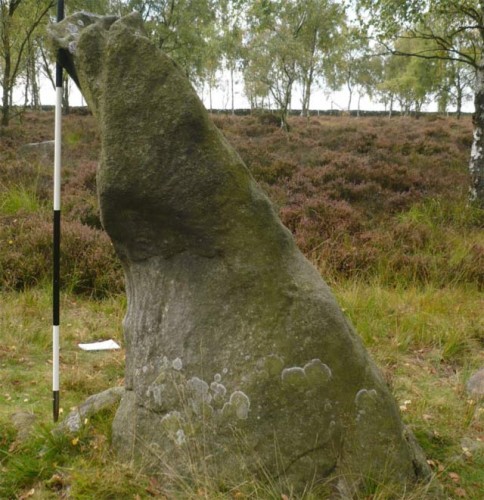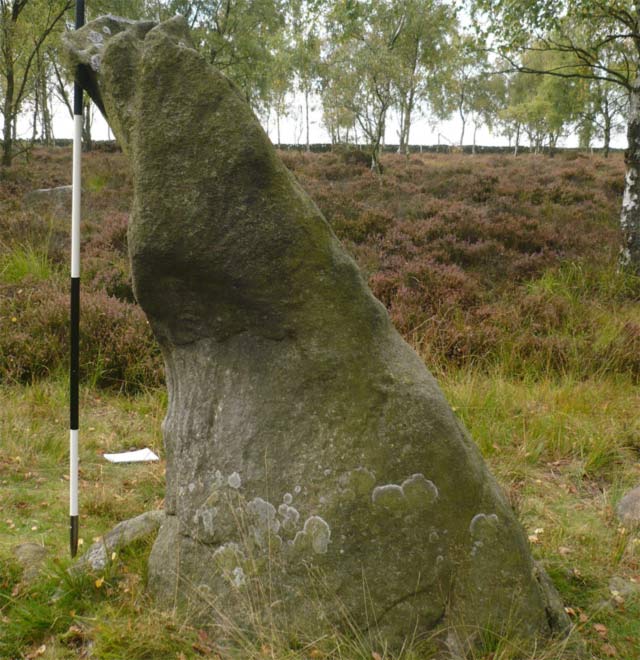 Being dated possibly slightly earlier than Stonehenge, by around 200 years, isn’t it just possible that the Gardom’s Edge Monolith represents a baby step, or a trial run to producing one of the great structures of our predecessors? The Egyptians did not just jump into building The Great Pyramids at Giza. Those represent the end of a process of increasingly larger structures and a learning process that was not always successful. In recent centuries we applied knowledge gained through construction of irrigation ditches handed down through centuries and millennia by our ancestors to construct the Suez and Panama canals. Today, we model engineering projects on computers and subject them to simulated stresses from both natural and man made stresses.
Being dated possibly slightly earlier than Stonehenge, by around 200 years, isn’t it just possible that the Gardom’s Edge Monolith represents a baby step, or a trial run to producing one of the great structures of our predecessors? The Egyptians did not just jump into building The Great Pyramids at Giza. Those represent the end of a process of increasingly larger structures and a learning process that was not always successful. In recent centuries we applied knowledge gained through construction of irrigation ditches handed down through centuries and millennia by our ancestors to construct the Suez and Panama canals. Today, we model engineering projects on computers and subject them to simulated stresses from both natural and man made stresses.
Ancient humans could only get their hands dirty, then look at what they created and say, hmmm, what if …?
Then hold a “kegger.”
Published on: Thu, Mar 29th, 2012
By John Shanks
http://www.sci-news.com/archaeology/article00237.htmlResearchers Say Gardom’s Edge Monolith Is Astronomical Marker
A team of researchers from the Nottingham Trent University has suggested that a 4000-year-old unique triangular shaped monolith, known as the Gardom’s Edge monolith, was aligned to be an astronomical marker.
The Gardom’s Edge Monolith (Daniel Brown / Nottingham Trent University)
The 2.2 meter high monolith, located in the Peak District National Park near Manchester, UK, has a striking, right-angled triangular shape that slants up towards geographic south. The orientation and inclination of the slope is aligned to the altitude of the Sun at mid-summer.
The team believes that the monolith was set in place to give symbolic meaning to the location through the changing seasonal illuminations. The findings will be published in the conference proceedings of SEAC 2011.
The researchers have conducted a microtopography survey of the surface surrounding the monolith. The findings indicate the presence of packing stones around the base of the monolith, evidence that it was placed carefully in position. They have also carried out 3-D modeling of illumination of the stone through the seasons, adapting for changes in the Earth’s tilt to the ecliptic plane over four millennia.
The landscape surrounding the stone harbors many ancient monuments such as Bronze Age roundhouses, a late Neolithic enclosure, and other traces of a long lasting human occupation.
The researchers believe that the stone is also late Neolithic, set in place around 2000 BC.
“Given the sensitivity of the site, we can’t probe under the surface of the soil,” explained Dr. Daniel Brown, a lead author and an astronomy lecturer at the Nottingham Trent University. “However, through our survey, we have found a higher density of packing stones on one side, supporting the case that the stone has been orientated intentionally.”
The 3-D modeling shows that during the winter half-year, the slanted side of the stone would remain in permanent shadow, during most of the summer half-year it would only be illuminated during the morning and afternoon, and close to midsummer it would be illuminated all day. The team is currently backing up the modeling work by gathering contemporary photographic evidence of the stone.
“The stone would have been an ideal marker for a social arena for seasonal gatherings,” Dr. Brown said. “It’s not a sundial in the sense that people would have used it to determine an exact time. We think that it was set in position to give a symbolic meaning to its location, a bit like the way that some religious buildings are aligned in a specific direction for symbolic reasons.”
The researchers hope that the new evidence will support the case for a wider archaeological survey of the site.
“The use of shadow casting in monuments of this period is quite rare in the British Isles,” Dr. Brown concluded. “But there are some examples including New Grange, Ireland, and some Clava cairns in the north-east of Scotland that have been proposed to include the intentional use of shadows. Both are associated to burial sites using the symbolism of a cyclic light and shadow display to represent eternity. Given the proximity of the Neolithic enclosure and possible ritual importance of this site, the Gardom’s Edge monolith could be another such example.”
Many and varied books and television shows, websites and other media outlets deal with the questions of structures we find left behind from the past. All too often the answers they arrive at involve aliens and lost technology and mysterious energies that we have lost the ability to either perceive or manipulate. Often, all three. Answers that only lead to far greater and, in my opinion, far more implausible questions.
All that an honest search for answers has to work with is extrapolation from evidence at the site and correlation to evidence from other similar sites. Every time we discover or decode some small item like this, it gives us another tiny piece of the puzzle. In the end, both building and deciphering the mysteries of our past comes to getting our hands dirty the old fashioned way.
Let’s give Humanity some credit in place of forcing ourselves into the role of perpetual children constantly looked over by parents, gods or aliens.
6 comments




